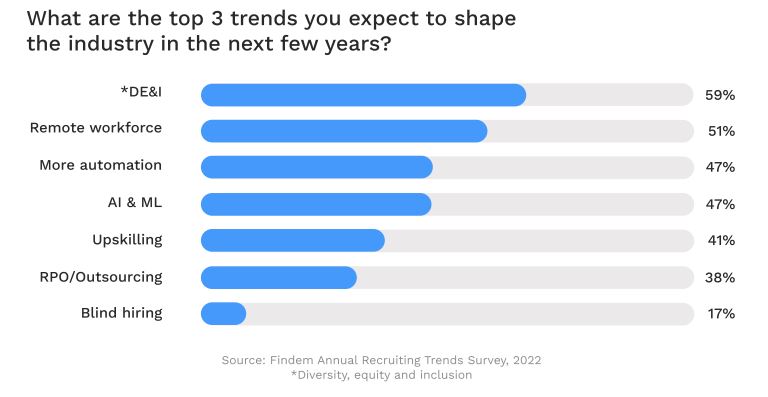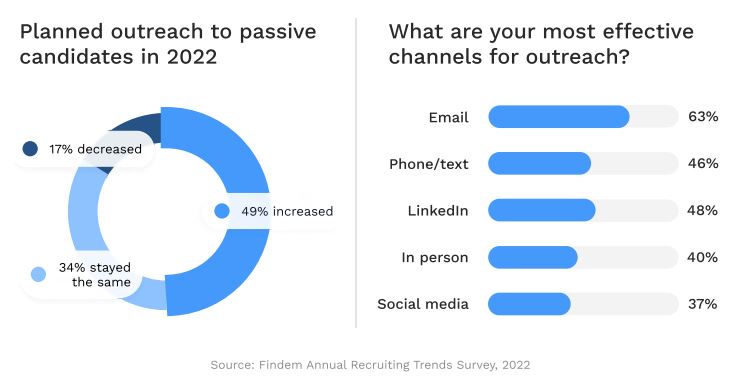Diversity is the top hiring priority for 2022
Passive recruitment is also climbing up the agenda.
Why You Should Care
HR teams are prioritizing diversity this year, according to Findem.
They are also transitioning away from inbound applications, and focusing on attracting passive candidates.
Here is how HR tech can help.
The world is living through an attrition crisis, which has been dubbed the ‘Great Resignation’.
This is challenging businesses as whole, but talent teams have been on the frontline of this so-called “recruiting rollercoaster”, in the words of talent tech company Findem.
In this context, Findem has explored the trends and challenges facing talent teams in its annual study of 100 senior HR leaders.
This year’s Annual Recruiting Trends report found that diversity hiring was the top priority for talent teams with 57% of the vote. 46% said automating processes, 45% said filling roles, and 23% said upskilling and reskilling were top priorities this year.

While diversity hiring wasn’t the top challenge for the respondents, they identified sourcing (49%), candidate experience (40%), and the interview process (50%) as the main issues they are facing around diverse recruitment.
Diversity, equity, and inclusion was also the top trend for 2022 (59%); followed by remote working (51%), more automation (47%), artificial intelligence and machine learning (47%) and upskilling (41%).

While it is surprising to see diversity outrank remote work and upskilling (given they are leading factors in the ‘Great Resignation’), the report notes: “Diversity is virtually a superpower for all key performance metrics.
“As recruiters build their talent teams for high growth and performance, more diverse experiences and backgrounds can increase innovation, creativity, improve financial performance, and so much more.”
Ultimately, “in a highly competitive market, the more diverse your talent pool is, the more likely you are to find people no one else is looking for.”
In addition, everyone wants to work in diverse and inclusive workplaces, so if employers can show they are committed to diversity that will be beneficial for future talent attraction and retention.
Spotlight on passive recruitment
Findem’s report also identified a new hiring trend: the transition from inbound to outbound recruitment. Recruiters are increasingly trying to tap into so-called passive candidates who are not actively looking for a new job, but are dissatisfied with their current role.
52% of the HR leaders surveyed said they were sourcing candidates, while 28% of candidates come from inbound applications and 20% come from referrals.
49% also noted that they were planning to increase passive recruitment in 2022; just 17% said they were going to move away from this approach. Currently, HR teams are using email, phone calls, or texts, and LinkedIn to do their outbound sourcing.

But better passive sourcing needs better recruitment tools. While Findem’s study found that recruiters are using more tools than ever (64% said they rely on more technology than in 2021), 82% believe sourcing automation would increase their productivity.
Thankfully, sourcing is top of HR teams’ investment priorities for this year with 32% of the vote. This was followed by employer branding (19%), candidate experience (17%) and outreach tools (15%).
Findem reminds us that the “stack should be simplifying, streamlining, and setting recruiters up for success. It’s time for a complete audit of what’s working, what’s not, and what’s new in the market to address points of friction”.
Sign up to the UNLEASH Newsletter
Get the Editor’s picks of the week delivered straight to your inbox!

Chief Reporter, UNLEASH
Allie is an award-winning business journalist and can be reached at alexandra@unleash.ai.
Contact Us
"*" indicates required fields
Partner with UNLEASH
"*" indicates required fields